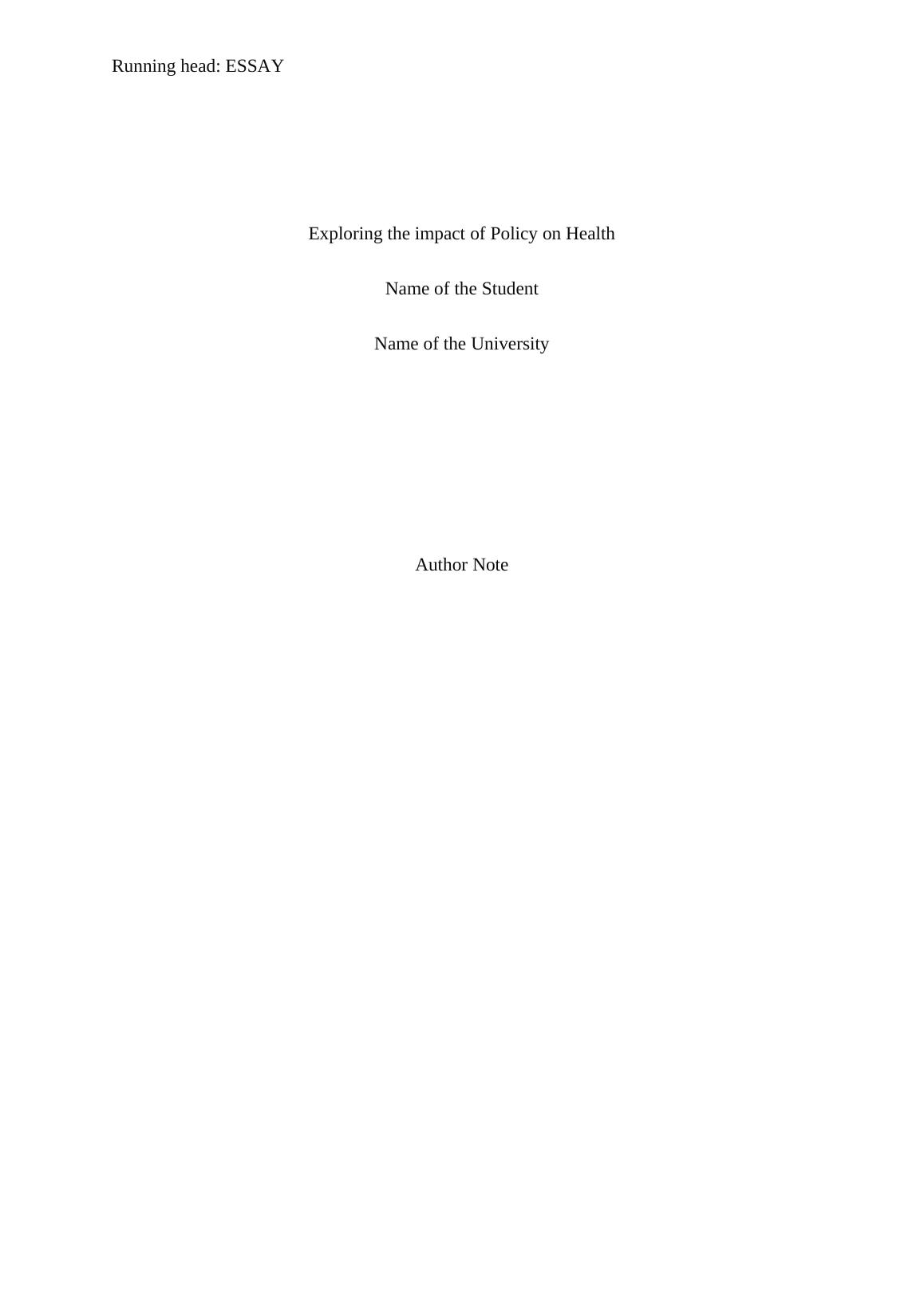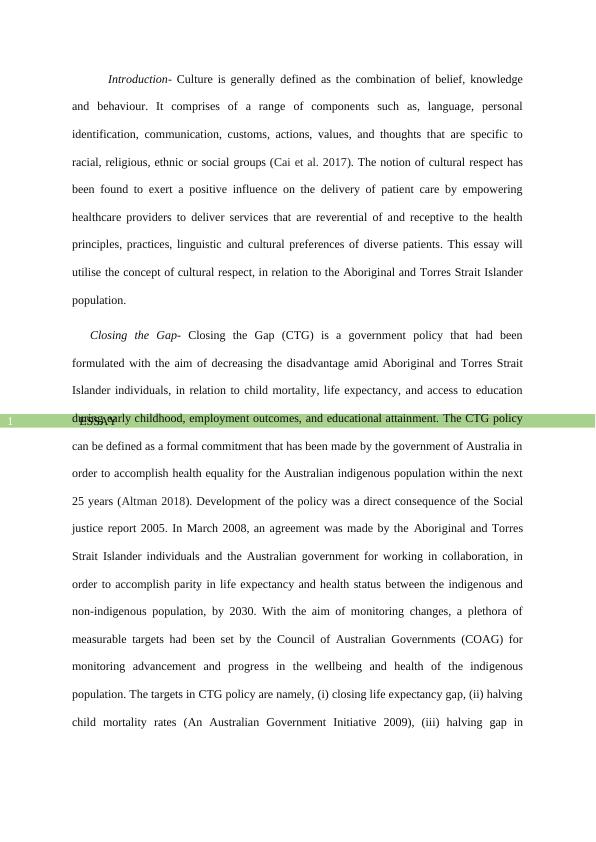Exploring the impact of Policy on Health | Essay
Added on 2022-09-07
9 Pages2526 Words15 Views
Running head: ESSAY
Exploring the impact of Policy on Health
Name of the Student
Name of the University
Author Note
Exploring the impact of Policy on Health
Name of the Student
Name of the University
Author Note

ESSAY1
Introduction- Culture is generally defined as the combination of belief, knowledge
and behaviour. It comprises of a range of components such as, language, personal
identification, communication, customs, actions, values, and thoughts that are specific to
racial, religious, ethnic or social groups (Cai et al. 2017). The notion of cultural respect has
been found to exert a positive influence on the delivery of patient care by empowering
healthcare providers to deliver services that are reverential of and receptive to the health
principles, practices, linguistic and cultural preferences of diverse patients. This essay will
utilise the concept of cultural respect, in relation to the Aboriginal and Torres Strait Islander
population.
Closing the Gap- Closing the Gap (CTG) is a government policy that had been
formulated with the aim of decreasing the disadvantage amid Aboriginal and Torres Strait
Islander individuals, in relation to child mortality, life expectancy, and access to education
during early childhood, employment outcomes, and educational attainment. The CTG policy
can be defined as a formal commitment that has been made by the government of Australia in
order to accomplish health equality for the Australian indigenous population within the next
25 years (Altman 2018). Development of the policy was a direct consequence of the Social
justice report 2005. In March 2008, an agreement was made by the Aboriginal and Torres
Strait Islander individuals and the Australian government for working in collaboration, in
order to accomplish parity in life expectancy and health status between the indigenous and
non-indigenous population, by 2030. With the aim of monitoring changes, a plethora of
measurable targets had been set by the Council of Australian Governments (COAG) for
monitoring advancement and progress in the wellbeing and health of the indigenous
population. The targets in CTG policy are namely, (i) closing life expectancy gap, (ii) halving
child mortality rates (An Australian Government Initiative 2009), (iii) halving gap in
Introduction- Culture is generally defined as the combination of belief, knowledge
and behaviour. It comprises of a range of components such as, language, personal
identification, communication, customs, actions, values, and thoughts that are specific to
racial, religious, ethnic or social groups (Cai et al. 2017). The notion of cultural respect has
been found to exert a positive influence on the delivery of patient care by empowering
healthcare providers to deliver services that are reverential of and receptive to the health
principles, practices, linguistic and cultural preferences of diverse patients. This essay will
utilise the concept of cultural respect, in relation to the Aboriginal and Torres Strait Islander
population.
Closing the Gap- Closing the Gap (CTG) is a government policy that had been
formulated with the aim of decreasing the disadvantage amid Aboriginal and Torres Strait
Islander individuals, in relation to child mortality, life expectancy, and access to education
during early childhood, employment outcomes, and educational attainment. The CTG policy
can be defined as a formal commitment that has been made by the government of Australia in
order to accomplish health equality for the Australian indigenous population within the next
25 years (Altman 2018). Development of the policy was a direct consequence of the Social
justice report 2005. In March 2008, an agreement was made by the Aboriginal and Torres
Strait Islander individuals and the Australian government for working in collaboration, in
order to accomplish parity in life expectancy and health status between the indigenous and
non-indigenous population, by 2030. With the aim of monitoring changes, a plethora of
measurable targets had been set by the Council of Australian Governments (COAG) for
monitoring advancement and progress in the wellbeing and health of the indigenous
population. The targets in CTG policy are namely, (i) closing life expectancy gap, (ii) halving
child mortality rates (An Australian Government Initiative 2009), (iii) halving gap in

ESSAY2
numeracy, writing and reading, (iv) halving educational attainment gap, (v) closing school
attendance gap, and (vi) halving gap in employment outcomes.
On analysing the case scenario, it can be suggested that the target that focuses on closing
gap related to life expectancy within the generation is most relevant. According to data from
the Australian Bureau of Statistics, life expectancy for Aboriginal and Torres Strait Islander
population had been found to be 17 years less than the rest of the population, during 1996-
2001. Life expectancy for indigenous males and females was reported to be 59 and 65 years
compared to 77 and 82 years for non-indigenous counterparts respectively. According to An
Australian Government Initiative (2009) life expectancy is governed by a range of factors
like socioeconomic status, accessibility of health services, environmental factors and risk
behaviour. Type 2 diabetes has also been correlated with a decreased life expectancy, with
cardiovascular disease being the primary reason behind death (Huo et al. 2016). According
to Australian Bureau of Statistics (2016) diabetes accounted for an estimated 4770 deaths in
2016 in Australia and was considered the seven leading reason for the same. Additionally, it
was the second leading reason for death of the indigenous Australian population and
accounted for 7.8% of all Aboriginal and Torres Strait Islander deaths in 2016. Owing to the
fact that standardised mortality for death was 5 times greater for indigenous population, the
target of CTG policy is most pertinent to the case. Showing adherence to the target will
ensure that Judy does not suffer from comorbid conditions, and would thereby reduce her risk
of death, thus increasing life expectancy.
Social determinants- The three social determinants that have mediated the potential health
challenges faced by Judy are namely, unemployment, instable housing and poor
socioeconomic status. Research evidences have elucidated that lack of a stable housing is
detrimental to the wellbeing and health of an individual. People who do not have a good
housing typically have to encounter high morbidity, and are susceptible to an increased risk
numeracy, writing and reading, (iv) halving educational attainment gap, (v) closing school
attendance gap, and (vi) halving gap in employment outcomes.
On analysing the case scenario, it can be suggested that the target that focuses on closing
gap related to life expectancy within the generation is most relevant. According to data from
the Australian Bureau of Statistics, life expectancy for Aboriginal and Torres Strait Islander
population had been found to be 17 years less than the rest of the population, during 1996-
2001. Life expectancy for indigenous males and females was reported to be 59 and 65 years
compared to 77 and 82 years for non-indigenous counterparts respectively. According to An
Australian Government Initiative (2009) life expectancy is governed by a range of factors
like socioeconomic status, accessibility of health services, environmental factors and risk
behaviour. Type 2 diabetes has also been correlated with a decreased life expectancy, with
cardiovascular disease being the primary reason behind death (Huo et al. 2016). According
to Australian Bureau of Statistics (2016) diabetes accounted for an estimated 4770 deaths in
2016 in Australia and was considered the seven leading reason for the same. Additionally, it
was the second leading reason for death of the indigenous Australian population and
accounted for 7.8% of all Aboriginal and Torres Strait Islander deaths in 2016. Owing to the
fact that standardised mortality for death was 5 times greater for indigenous population, the
target of CTG policy is most pertinent to the case. Showing adherence to the target will
ensure that Judy does not suffer from comorbid conditions, and would thereby reduce her risk
of death, thus increasing life expectancy.
Social determinants- The three social determinants that have mediated the potential health
challenges faced by Judy are namely, unemployment, instable housing and poor
socioeconomic status. Research evidences have elucidated that lack of a stable housing is
detrimental to the wellbeing and health of an individual. People who do not have a good
housing typically have to encounter high morbidity, and are susceptible to an increased risk

End of preview
Want to access all the pages? Upload your documents or become a member.
Related Documents
Aboriginal Nursing Assignment - NUR1201lg...
|10
|2718
|56
Contemporary Indigenous Health and Wellbeinglg...
|8
|1998
|199
Indigenous Health and Well-being Report 2022lg...
|9
|2261
|27
Contemporary Indigenous Health and Well-being | Essaylg...
|8
|2220
|524
Closing the Gap Strategy: A Governmental Approach to Achieve Health Equalitylg...
|17
|4482
|46
Closing The Gap (CTG) Policy and its Significance to Indigenous Australianslg...
|9
|2346
|488
